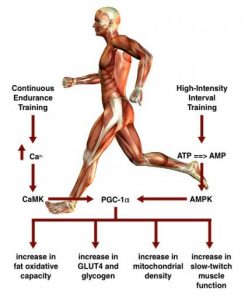The main contributor to the misuse of training methods like Tabata and high-intensity interval training (HIIT) in indoor cycling has more to do with how they are interpreted and embraced, and not that the methods are invalid. Many people are busy and also frustrated with the lack of results (or the speed of results) in their fitness. The pendulum swingers arrive on the scene and claim that this NEW way of training is the end-all. What happens, though, is that the pendulum swings completely to the other side and implies not only that this new way is the only “right” way, but that the “old” way was never valid.
Tom Goes Off-Road
Let me take this opportunity to help you understand why it has been a hard sell to get outdoor cyclists and competitive riders into indoor cycling classes (or the gym for that matter). Going back to our pendulum swingers: the groups of people they affect most are the fitness crowd and those stuck in between fitness and athletics (for example those branching out to attempt their first century ride, triathlon, or other event).
Let us look at the biggest difference between the fitness enthusiast vs. the athlete and how this difference has impacted who attends our indoor cycling classes.
It can be summed up in one word: performance. The athlete not only has to perform at a high level but is required to measure their performance.
On the other hand, fitness enthusiasts want simply to condition their body to improve their overall health. This may include weight loss, gaining strength, and body sculpting. There is nothing wrong with this, and obviously I want to encourage everyone to continue taking care of their body and staying healthy.
However, the proof of whether a training method like high-intensity interval training actually works is on the road, regardless of whether the individual rides outside or not.
So where am I going with this? When the fitness world gets swayed by yet another “new” way of training, we often don’t get to see if this is really effective because we are not truly putting it to the test. We just see some super-fit guy or girl touting how great it is (and “Hey, look at me”). Then an athlete looks at it and says (with some arrogance), “They don’t know what they are doing or how to really train.”
All arrogance aside, in most cases the athletes are correct. In many ways, this is how outdoor and competitive cyclists view indoor cycling.
There’s an App for That
As we reel this baby back into HIIT and indoor cycling, we find another case of here we go again. The problem is not indoor cycling or high-intensity interval training, but rather the contagious blanket statements that lead indoor cycling instructors astray. Research studies claim that HIIT results in better fat utilization, higher VO2 max, an increase in stroke volume, left-ventricle heart mass, and cardiac contractibility to name a few. Are these all good things? Yes. Are these research studies wrong or lying? No. So what’s the problem?
The problem is application.
First, they are often comparing high-intensity interval training to endurance training, which they inaccurately define as 30 to 60 minutes of continuous running or cycling. Let it be known that 30 to 60 minutes is NOT the definition of endurance training for everyone. I’ve been on “recreational” outdoor group rides with cyclists all around the country and I’ve yet to get home in an hour. Just to clarify, I’m not only riding with racers, but with those who motor along slowly at 12–14 mph and just like to ride. So if one ONLY trains using HIIT that consists of 5-second to 3-minute intense efforts followed by 20 seconds on up to 4 minutes of active recovery, how effective will the training be if the person has to endure 2+ hours in the saddle at close to 75%–80% of their maximal perceived effort? This is where the studies are misleading.
That’s a Lot of Science Stuff
 High-intensity interval training studies claim increases in oxidative enzymes such as citrate synthase, malate dehydrogenase, and succinate dehydrogenase, and increases in mitochondrial density and more effective signaling through the AMPK pathway.
High-intensity interval training studies claim increases in oxidative enzymes such as citrate synthase, malate dehydrogenase, and succinate dehydrogenase, and increases in mitochondrial density and more effective signaling through the AMPK pathway.
I’m not debating this…I have a hard time pronouncing these words. However, when a 4-hour bike race is concluded, scientists don’t go and start measuring oxidative enzymes: “The winner is…Number 354 with the highest level of citrate synthase!”
No, the winner is the one who has endured the challenges of the terrain and distance and came across the finish line first.
So, when a marathoner or triathlete who trains solely with HIIT wins, then HIIT will have our attention and will have proven something.
As usual, we need both, but….
It is usually no big surprise to find out that when the dust clears and the emotions subside, both types of training are necessary to produce well-rounded fitness for both the enthusiast and athlete. However, I’ll leave you with two things to consider when applying this to your indoor cycling classes:
(1) HIIT (like Tabata) is not a license to justify blood-snorting intervals in all of your classes. High-intensity intervals (usually defined as 80%–100% of max effort) should be greatly limited in the early part of the year in our classes and always sprinkled with caution depending on our demographic.
(2) Endurance training should also be limited during indoor cycling classes.
 Yes, you heard me right. Classes of 45–60 minutes are not the best format for performing extended low-intensity (60%–70% max) efforts. Classes that are 90 minutes or greater are more suited for those long, steady efforts. There is still plenty of highly effective and appropriate training to do during indoor cycling classes in the early season (base building) such as muscular endurance, steady-state tempo (Zone 3), muscular strength, and leg-speed work to name a few.
Yes, you heard me right. Classes of 45–60 minutes are not the best format for performing extended low-intensity (60%–70% max) efforts. Classes that are 90 minutes or greater are more suited for those long, steady efforts. There is still plenty of highly effective and appropriate training to do during indoor cycling classes in the early season (base building) such as muscular endurance, steady-state tempo (Zone 3), muscular strength, and leg-speed work to name a few.
Remember: Real Training. Real Cycling. Real Results. All beautifully packaged in a fun wrapper.
This article was originally posted in April 2012.


I appreciate the article and find that these remind me to change up some of the routines since it is easy for our bodies to adapt to the routines we provide. I use the HIIT to “shock the body” so we can build endurance. I use other routines as well. I keep the timing short since I have a client base that for the most part are beginners. So my overall goal is to get them to have fun, sweat and see that they really can, with time and commitment achieve a better level of fitness.
As usual this was a most appropriate and timely article to remind us to keep focusing on the things that really make cycling sense and discourage our clients from jumping on some silly bandwagon or the newest “fitness trend”. For those who are interested in using more intervals in their classes I remind you of a recent article from Jennifer entitled “Indoor Cycling Association Profile Template” that addresses using intervals at LT or FTP. This was an excellent overview of using intervals in your class profiles and although focusing on LT,FTP, MSP, etc. one could use the variables and sample progression for ALL levels of intensity. This is really some good stuff folks so try it out…….
AWESOME ARTICLE!! Well said! I’m so glad that you have shared this with us! If only ALL INDOOR CYCLING instructors follow this.
Thanks for sharing!! Love your articles and your wise input!! 🙂 🙂
Amazing Article! Thank you!
I’ve been telling my clients this for years!
But you start to second guess yourself with all the articles and research coming out about intervals!
So thank you so much!
Loving all the amazing info you are sharing with us!
Velocity – thanks for posting that Tweet. It is so true! I did a search and am now following @ffflow. Love to follow people who preach intelligent training!
Great little article – but showing a balanced article not only able to correct the HIIT bandwagon – but also the endurance athletes – well done. Saw a great tweet today which I thought summed up very similar examples in your piece.Tweeted today from @ffflow
Let’s not get too carried away with HIIT for endurance – Usain Bolt isn’t in the mix for 10,000m gold.
If had been listening to this in a car, that Tangerine Dream feel would have probably sent me drifting off the road. I wish the class I took over liked techno music. I sneak it in here and there.
Kala – I have to say that I love pretty much all the music you play in your classes and use them myself when I teach! I like this song as a warm up to create some good energy in the class before we get into our ride, it’s upbeat and fun!
With another instructor trying to get him to understand that HIIT is not the end all, be all/only thing to focus on in an indoor class… I should print this article out for him and drop it off 😉
Well written Tom. I think it is important to emphasize the length of intervals, they can be longer than 1 min and depending on what the training goal will determine what length of time you are using. This is very helpful for members I find.
Nice piece Tom, and you even made me giggle there a few times. I had to completely agree with the statement about the definition of endurance training….I rarely ride for less than two hours (unless it’s below 25 degrees out), most of my rides (I am a recreational rider, do not race) are in the 3-5 hr range now, and 4-7 hr range probably by June/July. When I did a very hilly 525 mile ride in 6 straight days last August, I don’t think I could have completed it without riding 5+ hour days in training and climbing hills. In other words I had to do in training what I was expected to do for my event. Did I balance those endurance training rides with some HIIT indoor cycling sessions? You bet! It was all about balance and I am thankful I did both.